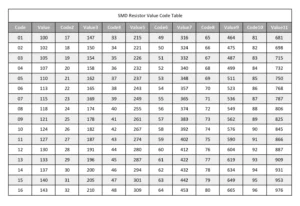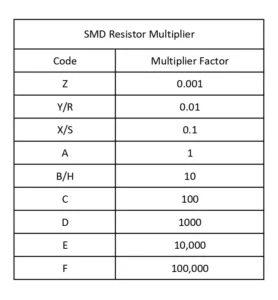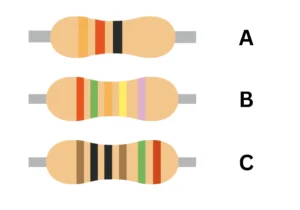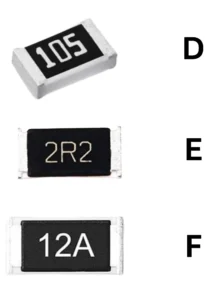Resistors are the most common PCB components. They are tiny and often have curved surfaces, making printing large numbers challenging. Hence, the international association decided to express them in coded formats. Most PCB resistors are color-coded. If you are looking for “how to read a resistor, ” you are at the right place.
A resistor is a crucial element of a circuit. It is often called a passive component of a PCB. A resistor is mainly used to impede or resist electrical current. By doing so, it can control the voltage and current levels. You have already learned how resistors affect voltage and current from high school.
This article mainly talks about how to read a resister of different types. There are several types of codes you may find on resistors. You will learn all those consecutively.
Resistor and Types
On PCB, you can find two major types of resistors: TH resistor and SMD resistor. Each comes with unique features and limitations. Also, they have different code labeling. To learn how to read a resistor, you must be familiar with varying labeling formats.
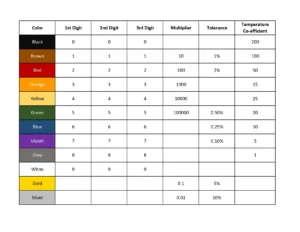
Through Hole Resistor
A TH resistor is a traditional type of resistor that consists of long wire leads inserted into holes on a PCB and then soldered in place. These types of resistors often have color coding. You can generally find four kinds of color coding on through-hole resistors.
#1. 3 Band Color Code Resistor
A 3-band resistor is the simplest one that uses three different color bands to show the resistor value. The first color band tells the first digit of the actual resistance value. Consecutively, the second band shows the second digit. Finally, the third band is the multiplier, which tells you how many zeros to add.
#2. 4 Band Resistor Color Code
This type of resistor uses four color bands to show the resistance value. Like the above type, the first band indicates the first digit in the resistance value. The second band indicates the second digit of the resistance value. The third band indicates the multiplier. Finally, the fourth band indicates the tolerances.
#3. 5 Band Resistor Color Code
This type of resistor comes with an extra color band. The first, second, and third bands indicate the primary resistance value. Following this, the fourth band indicates the multiplier, and the fifth band indicates the tolerances.
#4. 6 Band Color Code Resistor
Finally, this type of resistor includes another color band along with the previous type. Like before, the first, second, and third bands indicate the resistance value’s first, second, and third digits. The fourth band indicates the multiplier and the fifth band indicates the tolerances. Finally, the sixth band typically tells you the resistor’s temperature coefficient.
SMD Resistor
SMD resistors are also widely used on PCBs. However, these resistors are smaller than through-hole resistors. Like through-hole resistors, they also come with specific code labeling, but instead of color bands, they use direct numerical codes.
You might be making mistakes if you think these numerical codes are the actual value. You will need to translate them further to find the actual resistance value. In general, SMD resistors have four types.
#1. 3 Digit SMD Resistor Code
As the name suggests, these resistors come with a three-digit numerical code. The two leftmost values are the main resistance value, and the third one is the multiplier.
#2. R-coded Resistors
This resistor is another popular type of resistor. It is mainly used in low-power PCBs. You will find a unique character here, “R,” which generally represents the decimal point.
#3. 4 Digit SMD Resistor Code
This kind of resistor uses four digits to represent the given resistance value. The first three figures signify the first three figures of the resistance value, and the fourth digit represents the multiplier.
#4. EIA-96 SMD Resistor Code
EIA stands for Electronic Industrial Association, an international electronic manufacturing standard. The EIA-96 is mainly used for SMD resistors, prevalent for high-system precision works. This code also comes with a three-digit system.
Typically, it is composed of two figures combined with a small letter. The first two numbers you see will give you the resistance value. The last character will tell you what you multiply that resistance value by.
Both characters have a specific standard table from which you must find the exact resistance value. You will learn more about it in the next section.
How to Read a Resistor Color Code?
Understanding the color code table is critical to reading a resistor. The table typically consists of a series of colors and values for each color. Let’s look at the table above, and we can divide it into five main segments.
- The color band column is on the table’s leftmost side. It shows different colors that represent values for resistors.
- Right after the color band column, you can see three columns named 1st, 2nd, and 3rd These three columns represent values for each color. These columns are the first three digits of the resistance value, ranging from 0 to 9.
- The next column is for the multiplier. It means the number of zeros you should add right after the three digits of the resistance value. It typically ranges from 10-2 to 107.
- The tolerance value is next to the multiplier column. It typically ranges from 0.05% to 10%. Silver indicates the largest tolerance, 10%, in the table.
- Finally, the last column represents the temperature coefficient. It is typically measured in ppm/K and ranges from 1 ppm/K to 200 ppm/k.
Example #1 The Resistor A
The figure shows that the first resistor, labeled as A, has three color bands. So, you can identify this resistor as a 3-band color code resistor. The first two color bands indicate the two digits of the resistance value. The final color band represents the multiplier.
So, resistor A has a color sequence of Orange, Red, and Black. Now, look at the table and find the values. It is 32 x 100 = 32 ohms.
Example #2 The Resistor B
The second resistor, B, has five color bands. From the previous discussion, you know this type of resistor has three significant digits, one multiplier, and one tolerance color band.
Resistor B has a color sequence of Red, Green, Orange, Yellow, and Violet. Now, look at the table and try to find the values. It should be 253 x 104 ± 0.10% = 2530 KΩ ± 0.10%. It is comparatively a very high resistance.
Example #3 The Resistor C
The third resistor, C, has six color bands. From the previous discussion, you know that this type of resistor comes with additional color bands. The extra color band indicates the resistor’s temperature coefficient.
Resistor C has a color sequence of Brown, Black, Black, Brown, Green, and Red. Now, look at the table and try to find the values. It should be 100 x 101 ± 0.5% = 1 KΩ with a temperature co-efficient of 50 ppm/K.
How to Read a Resistor with Direct Markings (SMD Resistor)?
In the previous section, you learned how to read a color-coded resistor or through a hole resistor. In this part, you will learn how to read SMD resistors. However, you may already have some basic ideas from the previously mentioned section.
Example #1 SMD Resistor D
Resistor D shows 105, so it is a three-digit SMD resistor. In this type of resistor, the first two digits represent the significant values, and the last digit is the multiplier. So, the value is 10 x 105 = 1000 KΩ.
Example #2 SMD Resistor E
Resistor E shows 2R2. In this type, the R represents the decimal point of the resistance value. Here, 2R2 means 2.2 Ω.
Example #3 SMD Resistor F
Resistor F is a particular type of resistor called an EIA-96 SMD resistor. It has three characters; the first two represent the significant resistance value, and the last character represents the multiplier. According to the table, this value should be 130 x 1 = 130 Ω.
Reading Direction and Tips
A resistor is typically read from left to right. But how do you know which side is the left side? This is a common problem with color-coded resistors. In this case, you can follow two tricks.
- Observe the spacing between the color bands. The short spacings are always located on the left side.
- You can also check the highest number of colorings. Typically, they are located at the left side of the resistor.
- The first ring of the resistor is always close to one of the leads. The last ring, typically gold or silver, is the tolerances.
Final Thought
This detailed guide covers all of the information needed to read a resistor. However, first, identify the type of resistor you’re working with. So, what types of code labeling are there? Is it color or character-coded? Use the table to calculate the actual resistance value based on this information.
Understanding the resistance value is critical when working with PCBs. We hope this tutorial has helped you gain the knowledge you need for your project. If you still have questions, get expert help.

